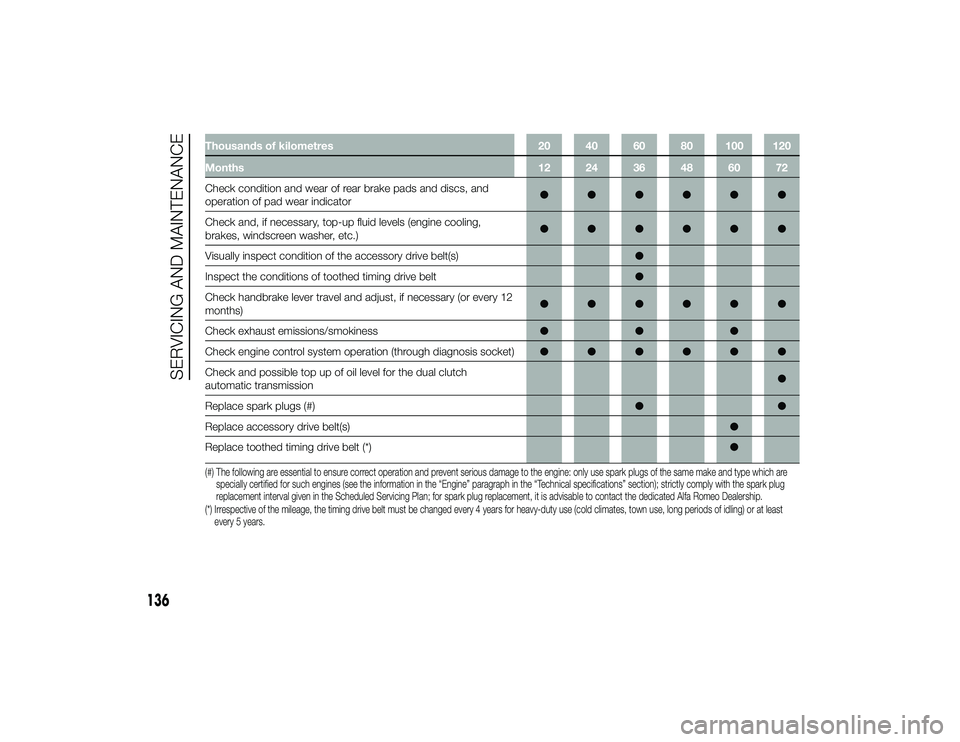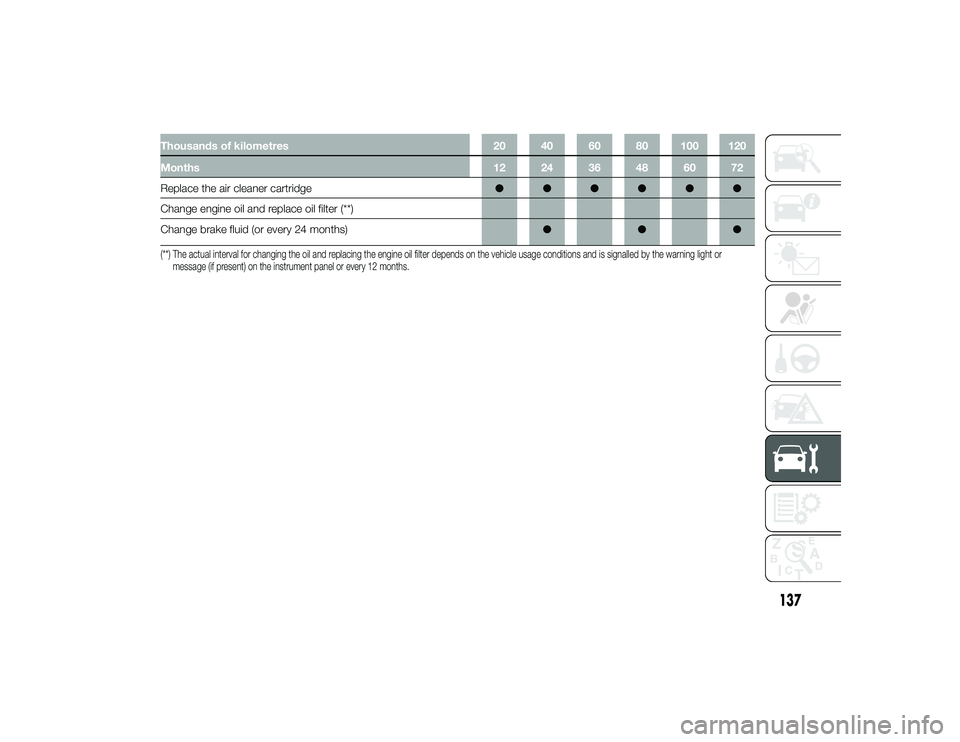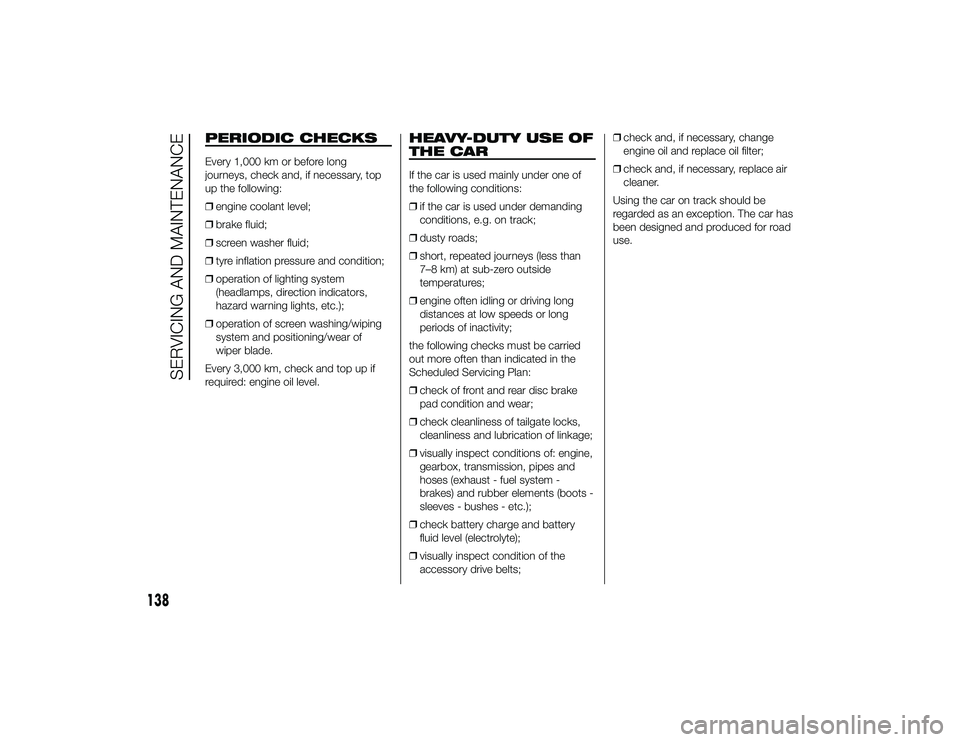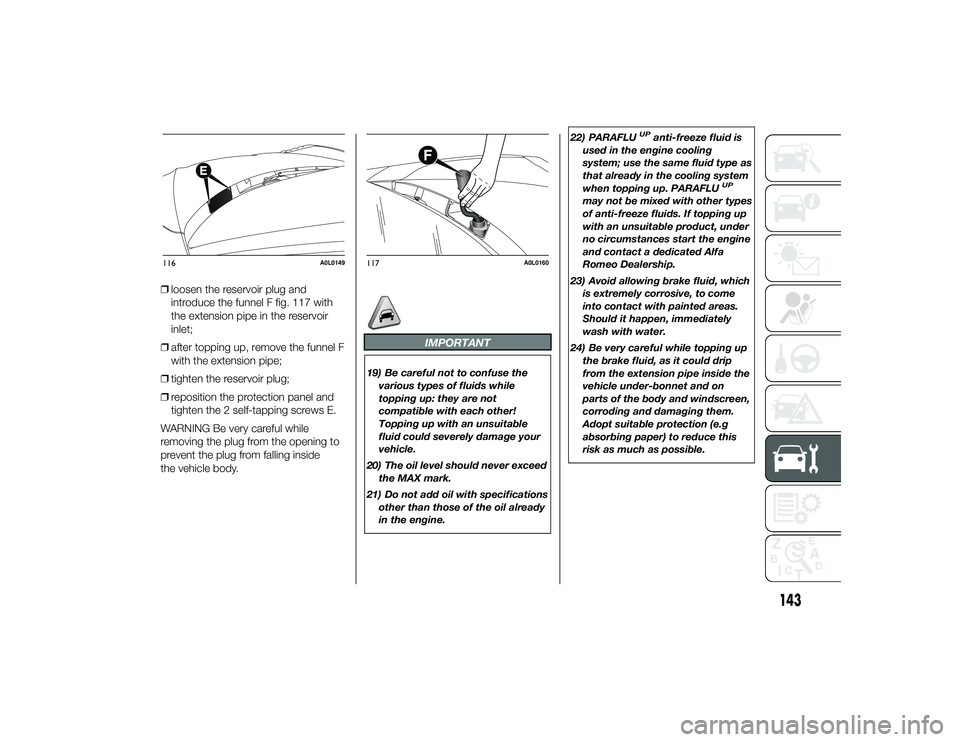engine Alfa Romeo 4C 2014 Owner handbook (in English)
[x] Cancel search | Manufacturer: ALFA ROMEO, Model Year: 2014, Model line: 4C, Model: Alfa Romeo 4C 2014Pages: 190, PDF Size: 7.87 MB
Page 139 of 190

Thousands of kilometres20 40 60 80 100 120
Months 12 24 36 48 60 72
Check condition and wear of rear brake pads and discs, and
operation of pad wear indicator ●●●●●●
Check and, if necessary, top-up fluid levels (engine cooling,
brakes, windscreen washer, etc.) ●●●●●●
Visually inspect condition of the accessory drive belt(s) ●
Inspect the conditions of toothed timing drive belt ●
Check handbrake lever travel and adjust, if necessary (or every 12
months) ●●●●●●
Check exhaust emissions/smokiness ●●●
Check engine control system operation (through diagnosis socket) ●●●●●●
Check and possible top up of oil level for the dual clutch
automatic transmission ●
Replace spark plugs (#) ●●
Replace accessory drive belt(s) ●
Replace toothed timing drive belt (*) ●(#) The following are essential to ensure correct operation and prevent serious damage to the engine: only use spark plugs of the same make and type which are
specially certified for such engines (see the information in the “Engine” paragraph in the “Technical specifications” section); strictly comply with the spark plug
replacement interval given in the Scheduled Servicing Plan; for spark plug replacement, it is advisable to contact the dedicated Alfa Romeo Dealership.
(*) Irrespective of the mileage, the timing drive belt must be changed every 4 years for heavy-duty use (cold climates, town use, long periods of idling) or at least every 5 years.
136
SERVICING AND MAINTENANCE
24-9-2013 11:50 Pagina 136
Page 140 of 190

Thousands of kilometres20 40 60 80 100 120
Months 12 24 36 48 60 72
Replace the air cleaner cartridge ●●●●●●
Change engine oil and replace oil filter (**)
Change brake fluid (or every 24 months) ●●●(**) The actual interval for changing the oil and replacing the engine oil filter depends on the vehicle usage conditions and is signalled by the warning light or
message (if present) on the instrument panel or every 12 months.
137
24-9-2013 11:50 Pagina 137
Page 141 of 190

PERIODIC CHECKSEvery 1,000 km or before long
journeys, check and, if necessary, top
up the following:
❒engine coolant level;
❒ brake fluid;
❒ screen washer fluid;
❒ tyre inflation pressure and condition;
❒ operation of lighting system
(headlamps, direction indicators,
hazard warning lights, etc.);
❒ operation of screen washing/wiping
system and positioning/wear of
wiper blade.
Every 3,000 km, check and top up if
required: engine oil level.
HEAVY-DUTY USE OF
THE CARIf the car is used mainly under one of
the following conditions:
❒ if the car is used under demanding
conditions, e.g. on track;
❒ dusty roads;
❒ short, repeated journeys (less than
7–8 km) at sub-zero outside
temperatures;
❒ engine often idling or driving long
distances at low speeds or long
periods of inactivity;
the following checks must be carried
out more often than indicated in the
Scheduled Servicing Plan:
❒ check of front and rear disc brake
pad condition and wear;
❒ check cleanliness of tailgate locks,
cleanliness and lubrication of linkage;
❒ visually inspect conditions of: engine,
gearbox, transmission, pipes and
hoses (exhaust - fuel system -
brakes) and rubber elements (boots -
sleeves - bushes - etc.);
❒ check battery charge and battery
fluid level (electrolyte);
❒ visually inspect condition of the
accessory drive belts; ❒
check and, if necessary, change
engine oil and replace oil filter;
❒ check and, if necessary, replace air
cleaner.
Using the car on track should be
regarded as an exception. The car has
been designed and produced for road
use.
138
SERVICING AND MAINTENANCE
24-9-2013 11:50 Pagina 138
Page 142 of 190

CHECKING LEVELS.The topping-up plug B and the dipstick A for checking the engine oil level and the reservoir C for the engine coolant can be
accessed by lifting the tailgate (see the procedure in the "Bonnet/Luggage Compartment" paragraph in the "Knowing your car"
chapter).
19)113) 114) 115)110
A0L0152
139
24-9-2013 11:50 Pagina 139
Page 144 of 190

ENGINE OIL
Check that the oil level is between the
MIN and MAX marks on the dipstick
A fig. 110.
For this check, take out the dipstick
from its seat, clean it with a lint-free
cloth, reinsert the dipstick; take it out
again and check the oil level.
116)
If the oil level is near or under the MIN
mark, add oil through the filler B fig.
110 until it reaches the MAX mark.
20)
Take out the engine oil dipstick A, clean
it with a lint-free cloth and reinsert it.
Extract the engine oil dipstick again and
check that the level is between the
MIN and MAX marks on the dipstick.
116)
The range between the MIN and MAX
levels corresponds to approximately
1 litre of oil.
Engine oil consumption
21)
3)
The maximum engine oil consumption
is usually 400 grams every 1,000 km.
When the car is new, the engine needs
to run in, therefore the engine oil
consumption can only be considered
stabilised after the first 5,000 - 6,000
km.IMPORTANT After adding or changing
the oil, let the engine run for a few
seconds and wait a few minutes after
stopping it before you check the level.
ENGINE COOLANT
22)
117)
The coolant level must be checked
when the engine is cold and must
range between the MIN and MAX
marks on the reservoir.
If the level is too low, unscrew reservoir
plug C fig. 110 and add the fluid
described in the "Fluids and lubricants"
paragraph of the "Technical
Specifications" chapter.
WINDSCREEN WASHER
FLUID
118) 119)
To check the windscreen washer fluid
level, proceed as follows:
❒
to avoid any interference during the
procedure, lift the windscreen wiper
blade according to the "Windscreen
wiper" paragraph in the
"Maintenance and care" chapter;
❒ loosen the 4 self-tapping screws A
fig. 112 using the supplied
screwdriver. Remove the bonnet
grille;
❒ release the plug from the opening; ❒
leaving the plug close to the opening,
put a finger on the central hole B fig.
113 in the plug and remove it: the
level can be seen on the control pipe
C fig. 114 due to capillarity;
❒ after the check, reinsert the plug B
with the control pipe C in the initial
position;
❒ reposition the bonnet grille and
tighten the 4 self-tapping screws A.
WARNING Re-close the plug holding it
horizontally (not directed towards the
bonnet) to prevent the opening tang
from remaining locked in a position
difficult to reach.
It is recommended to check the
windscreen washer fluid regularly, in
particular in driving conditions needing
a heavier use of the windscreen washer.
112
A0L0130
141
24-9-2013 11:50 Pagina 141
Page 146 of 190

❒loosen the reservoir plug and
introduce the funnel F fig. 117 with
the extension pipe in the reservoir
inlet;
❒ after topping up, remove the funnel F
with the extension pipe;
❒ tighten the reservoir plug;
❒ reposition the protection panel and
tighten the 2 self-tapping screws E.
WARNING Be very careful while
removing the plug from the opening to
prevent the plug from falling inside
the vehicle body.
IMPORTANT
19) Be careful not to confuse the various types of fluids while
topping up: they are not
compatible with each other!
Topping up with an unsuitable
fluid could severely damage your
vehicle.
20) The oil level should never exceed the MAX mark.
21) Do not add oil with specifications other than those of the oil already
in the engine. 22) PARAFLU
UP
anti-freeze fluid is
used in the engine cooling
system; use the same fluid type as
that already in the cooling system
when topping up. PARAFLU
UP
may not be mixed with other types
of anti-freeze fluids. If topping up
with an unsuitable product, under
no circumstances start the engine
and contact a dedicated Alfa
Romeo Dealership.
23) Avoid allowing brake fluid, which is extremely corrosive, to come
into contact with painted areas.
Should it happen, immediately
wash with water.
24) Be very careful while topping up the brake fluid, as it could drip
from the extension pipe inside the
vehicle under-bonnet and on
parts of the body and windscreen,
corroding and damaging them.
Adopt suitable protection (e.g
absorbing paper) to reduce this
risk as much as possible.
116
A0L0149
117
A0L0160
143
24-9-2013 11:50 Pagina 143
Page 147 of 190

WARNING
113) The Alfa Romeo 4C is designedand produced for road use, in
compliance with the current
regulations. Vehicle use in the
track must be considered as
occasional and in any case under
the responsibility of the user.
The vehicle CANNOT be modified
or tampered with for any reason,
this would alter the Manufacturer
homologation and/or safety
requirements. Using a modified or
tampered product relieves the
Manufacturer from any
responsibility on it and may
expose people to serious risks.
114) Never smoke when performing operations in the engine
compartment. Flammable gases
and fumes may be present, with
the risk of fire.
115) Be very careful when working in the engine compartment if the
engine is hot: risk of burns. 116) If the engine oil is being topped
up, wait for the engine to cool
down before loosening the filler
plug, particularly for cars with
aluminium plug (for versions/
markets, where provided).
WARNING: risk of burns!
117) The cooling system is pressurised. If necessary, only
replace the plug with another
original one or the operation of
the system may be adversely
affected. Do not remove the
reservoir plug when the engine is
hot: risk of burns.
118) Do not travel with the windscreen washer reservoir
empty: the windscreen washer is
essential for improving visibility.
Repeated operation of the system
without fluid could damage or
cause rapid deterioration of some
system components.
119) Certain commercial additives for windscreen washer fluids are
inflammable. The engine
compartment contains hot
components which may set it on
fire. 120) Brake fluid is poisonous and
highly corrosive. In the event of
accidental contact, immediately
wash the affected parts with
water and mild soap. Then rinse
thoroughly. Call a doctor
immediately if swallowed.
121) The
symbol on the container
indicates a synthetic brake fluid,
which is different from a mineral
fluid. Using a mineral fluid will
damage the special rubber seals
of the braking system beyond
repair.IMPORTANT
3) Used engine oil and oil filters contain substances which are
harmful to the environment. You
are advised to go to a dedicated
Alfa Romeo Dealership to have
the oil and filters changed.
144
SERVICING AND MAINTENANCE
24-9-2013 11:50 Pagina 144
Page 148 of 190

AIR CLEANERFor cleaner replacement, contact a
dedicated Alfa Romeo Dealership.
BATTERYBattery A fig. 118 does not require the
electrolyte to be topped up with distilled
water. A periodic check carried out at
a dedicated Alfa Romeo Dealership
is, however, necessary to check
efficiency.
REPLACING THE
BATTERY
122) 123) 124) 125)25)4)
If necessary, replace the battery with
another original battery with the same
specifications. Follow the battery
manufacturer's instructions for
maintenance.USEFUL ADVICE FOR
EXTENDING THE LIFE OF
YOUR BATTERY
To avoid draining your battery rapidly
and maintain its efficiency over time,
carefully observe the following
instructions:
❒
when you park the car, ensure that
the doors and tailgate are properly
closed, to prevent roof lights inside
the passenger and luggage
compartments respectively from
staying on;
❒ switch off the roof lights; the car is,
however, equipped with a system
which switches the interior lights off
automatically;
❒ do not keep accessories (e.g. radio,
hazard warning lights, etc.) switched
on for a long time when the engine
is not running;
❒ before performing any operation on
the electrical system, disconnect
the negative battery cable.
IMPORTANT If the charge level remains
under 50% for a long time, the battery
is damaged by sulphation, reducing
its capacity and efficiency at start-up.118
A0L0138
145
24-9-2013 11:50 Pagina 145
Page 153 of 190

PRESERVING THE
BODYWORK
Paintwork
5)
27) 28)
Touch up abrasions and scratches
immediately.
Maintenance of paintwork consists of
washing the car: the frequency
depends on the conditions and
environment where the car is used. For
example, in highly polluted areas, or if
the roads are spread with salt, it is
advisable to wash the car more
frequently.
To correctly wash the car, proceed as
follows:
❒if high pressure jets or cleaners are
used to wash the car, keep a
distance of at least 40 cm from the
bodywork to avoid damage or
alteration. It should be remembered
that the build up of water can
damage the car over a period of
time;
❒ wash the bodywork using a low
pressure jet of water;
❒ wipe a sponge with a slightly soapy
solution over the bodywork,
frequently rinsing the sponge;
❒ rinse well with water and dry with a
jet of air or a chamois leather. Dry the less visible parts (e.g. door
frames, bonnet, headlight frames, etc.)
with special care, as water may
stagnate more easily in these areas.
The car should not be taken to a closed
area immediately, but left outside so
that residual water can evaporate.
Do not wash the car after it has been
left in the sun or with the tailgate hot:
this may alter the shine of the
paintwork.
Exterior plastic parts must be cleaned
in the same way as the rest of the car.
Avoid parking under trees as much
as possible; the resin from trees dulls
the paintwork.
IMPORTANT Bird droppings must be
washed off immediately and thoroughly
as the acid they contain is particularly
aggressive.
Windows
Use specific detergents and clean
cloths to prevent scratching or altering
the transparency.
Front headlights
Use a soft cloth soaked in water and
detergent for washing cars.
IMPORTANT Never use aromatic
substances (e.g. petrol) or ketenes (e.g.
acetone) for cleaning the plastic lenses
of the front headlights.
Engine compartment
At the end of the winter the engine
compartment should be carefully
washed, without directing the
jet against any electronic control unit.
Have this operation performed at a
specialised workshop.
IMPORTANT The washing should take
place with the engine cold and the
ignition key in the STOP position. After
the washing operation, make sure
that the various protections (e.g. rubber
caps and guards) have not been
removed or damaged.
150
SERVICING AND MAINTENANCE
24-9-2013 11:50 Pagina 150
Page 156 of 190

TECHNICAL SPECIFICATIONS
Everything you may find useful for
understanding how your car is made
and works is contained in this chapter
and illustrated with data, tables and
graphics. For the enthusiasts and the
technician, but also just for those who
want to know every detail of their
car.IDENTIFICATION DATA....................154
ENGINE CODES - BODY
VERSIONS ......................................156
ENGINE ..........................................157
FUEL SUPPLY .................................158
TRANSMISSION .............................159
BRAKES .........................................160
SUSPENSION .................................161
STEERING ......................................162
WHEELS .........................................163
DIMENSIONS ..................................167
PERFORMANCE .............................168
WEIGHTS .......................................169
REFUELLING ..................................170
FLUIDS AND LUBRICANTS ............171
FUEL CONSUMPTION ....................174
CO2 EMISSIONS ............................175
PRESCRIPTIONS FOR HANDLING
THE VEHICLE AT THE END OF ITS
LIFE ................................................176
153
24-9-2013 11:50 Pagina 153